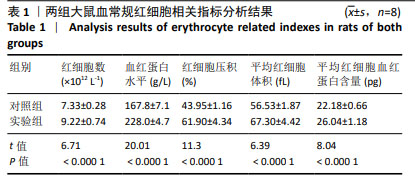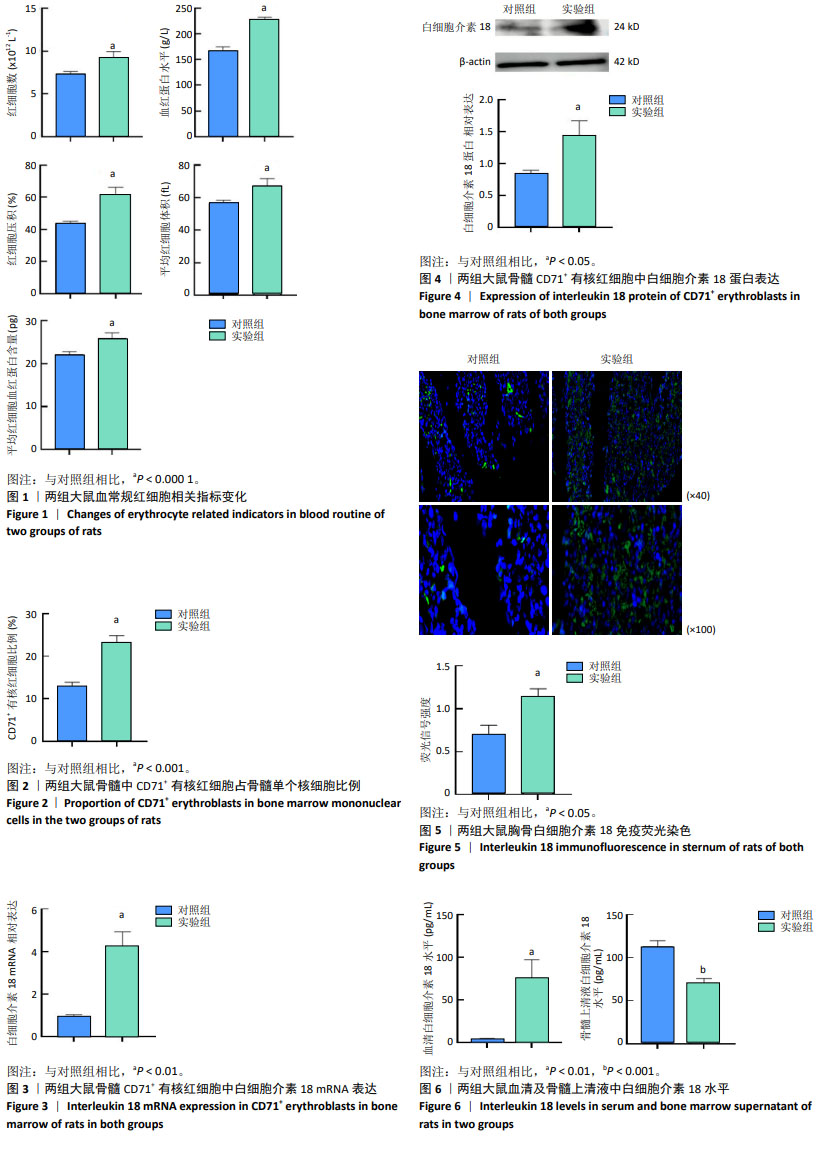[1] RICHALET JP, HERMAND E, LHUISSIER FJ. Cardiovascular physiology and pathophysiology at high altitude. Nat Rev Cardiol. 2024;21(2):75-88.
[2] VILLAFUERTE FC, SIMONSON TS, BERMUDEZ D, et al. High-Altitude Erythrocytosis: Mechanisms of Adaptive and Maladaptive Responses. Physiology (Bethesda). 2022;37(4):175-186.
[3] 熊权鑫.PI3K/AKT/NF-KB信号通路对高原红细胞增多症大鼠骨髓组织中HIF-1α表达变化的调控作用研究[D].成都:四川农业大学, 2018.
[4] PAN Y, ZHANG Y, YUAN J, et al. Tetrahydrocurcumin mitigates acute hypobaric hypoxia-induced cerebral oedema and inflammation through the NF-κB/VEGF/MMP-9 pathway. Phytother Res. 2020;34(11): 2963-2977.
[5] LIU H, TANG F, SU J, et al. EPAS1 regulates proliferation of erythroblasts in chronic mountain sickness. Blood Cells Mol Dis. 2020;84:102446.
[6] 马婕,冀林华,李占全,等.高原鼠兔与大鼠低氧后外周血及骨髓红系细胞变化特点[J].中国组织工程研究,2020,24(1):112-117.
[7] LIU HH, SU J, MA J, et al. The expression of VHL/HIF signaling pathway in the erythroid progenitor cells with chronic mountain sickness. Zhonghua Yi Xue Za Zhi. 2019;99(34):2670-2674.
[8] ZHANG L, LI M, WANG Z, et al. Cardiovascular Risk After SARS-CoV-2 Infection Is Mediated by IL18/IL18R1/HIF-1 Signaling Pathway Axis. Front Immunol. 2022;12:780804.
[9] IHIM SA, ABUBAKAR SD, ZIAN Z, et al. Interleukin-18 cytokine in immunity, inflammation, and autoimmunity: Biological role in induction, regulation, and treatment. Front Immunol. 2022;13:919973.
[10] WANG B, WANG X. Effects of interleukin-18 and hypoxia-inducible factor-1α in serum and gingival tissues of rat model with periodontitis exposed to chronic intermittent hypoxia. Hua Xi Kou Qiang Yi Xue Za Zhi. 2015;33(4):383-387.
[11] 廖霞,罗凤鸣.高原人群肺动脉高压与血红蛋白浓度的相关研究进展[J].中国呼吸与危重监护杂志,2022,21(3):225-228.
[12] 郭勇,王生艳,易静静,等.红景天苷对高原红细胞增多症模型大鼠骨髓CD71+有核红细胞凋亡的影响[J].吉林大学学报(医学版), 2023,49(5):1174-1181.
[13] 苏思骢.高原红细胞增多症病程中肠道微生物作用的探索研究[D].北京:军事科学院,2021.
[14] GATTERER H, VILLAFUERTE FC, ULRICH S, et al. Altitude illnesses. Nat Rev Dis Primers. 2024;10(1):43.
[15] LYU Q, BAI Y, CHENG J, et al. Intermittent short-duration reoxygenation protects against simulated high altitude-induced pulmonary hypertension in rats. FASEB J. 2021;35(2):e21212.
[16] SCHIPPEL N, SHARMA S. Dynamics of human hematopoietic stem and progenitor cell differentiation to the erythroid lineage. Exp Hematol. 2023;123:1-17.
[17] RYBNIKOVA E, LUKYANOVA L. Molecular Mechanisms of Adaptation to Hypoxia. Int J Mol Sci. 2023;24(5):4563.
[18] HU J, LIU J, XUE F, et al. Isolation and functional characterization of human erythroblasts at distinct stages: implications for understanding of normal and disordered erythropoiesis in vivo. Blood. 2013;121(16):3246-3253.
[19] BAPAT A, SCHIPPEL N, SHI X, et al. Hypoxia promotes erythroid differentiation through the development of progenitors and proerythroblasts. Exp Hematol. 2021;97:32-46.e35.
[20] DIXON KO, KUCHROO VK. IL-18: throwing off the shackles to boost anti-tumor immunity. Cell Res. 2020;30(10):831-832.
[21] BOURAS E, KARHUNEN V, GILL D, et al. Circulating inflammatory cytokines and risk of five cancers: a Mendelian randomization analysis. BMC Med. 2022;20(1):3.
[22] IVASHKIV LB. The hypoxia-lactate axis tempers inflammation. Nat Rev Immunol. 2020;20(2):85-86.
[23] 李英兰,娄明远,崔晓珊,等.海拔4300米高原红细胞增多症患者血清炎症因子及认知功能障碍的研究[R].青海省人民医院, 2019-11-20.
[24] HUANG H, YANG L. Research Progress of Inflammatory Factors in Chronic Obstructive Pulmonary Disease with Pulmonary Hypertension at High Altitude. Altern Ther Health Med. 2023;29(8): 689-693.
[25] LIU H, WANG Y, ZHANG Q, et al. Macrophage-derived inflammation promotes pulmonary vascular remodeling in hypoxia-induced pulmonary arterial hypertension mice. Immunol Lett. 2023;263: 113-122.
[26] PALAZON A, GOLDRATH AW, NIZET V, et al. HIF transcription factors, inflammation, and immunity. Immunity. 2014;41(4):518-528.
[27] CUMMINS EP, KEOGH CE, CREAN D, et al. The role of HIF in immunity and inflammation. Mol Aspects Med. 2016;47-48:24-34.
[28] ZHAO B, NIU X, HUANG S, et al. TLR4 Agonist and Hypoxia Synergistically Promote the Formation of TLR4/NF-κB/HIF-1α Loop in Human Epithelial Ovarian Cancer. Anal Cell Pathol (Amst). 2022;2022:4201262.
[29] ZHANG Z, HUANG Y, ZHANG J, et al. Activation of NF-κB signaling pathway during HCG-induced VEGF expression in luteal cells. Cell Biol Int. 2019;43(3):344-349.
[30] KORBECKI J, SIMIŃSKA D, GĄSSOWSKA-DOBROWOLSKA M, et al. Chronic and Cycling Hypoxia: Drivers of Cancer Chronic Inflammation through HIF-1 and NF-κB Activation: A Review of the Molecular Mechanisms. Int J Mol Sci. 2021;22(19):10701.
[31] SPIRIG R, DJAFARZADEH S, REGUEIRA T, et al. Effects of TLR agonists on the hypoxia-regulated transcription factor HIF-1alpha and dendritic cell maturation under normoxic conditions. PLoS One. 2010;5(6):e0010983.
[32] COUTINHO-WOLINO KS, ALMEIDA PP, MAFRA D, et al. Bioactive compounds modulating Toll-like 4 receptor (TLR4)-mediated inflammation: pathways involved and future perspectives. Nutr Res. 2022;107:96-116.
[33] KIANI AA, ELYASI H, GHOREYSHI S, et al. Study on hypoxia-inducible factor and its roles in immune system. Immunol Med. 2021;44(4): 223-236.
[34] MCGETTRICK AF, O’NEILL LAJ. The Role of HIF in Immunity and Inflammation. Cell Metab. 2020;32(4):524-536.
[35] CHEN Y, GABER T. Hypoxia/HIF Modulates Immune Responses. Biomedicines. 2021;9(3):260.
[36] TAO Z, WANG J, WEN K, et al. Pyroptosis in Osteoblasts: A Novel Hypothesis Underlying the Pathogenesis of Osteoporosis. Front Endocrinol (Lausanne). 2021;11:548812.
[37] ALLEGRA A, VINCELLI D, SPATARI G, et al. Evaluation of interleukin-18 levels in patients affected by multiple myeloma and monoclonal gammopathy of undetermined significance: analysis and review of the literature. Eur Rev Med Pharmacol Sci. 2024;28(12):3880-3887.
[38] FIORDI B, SALVESTRINI V, GUGLIOTTA G, et al. IL-18 and VEGF-A trigger type 2 innate lymphoid cell accumulation and pro-tumoral function in chronic myeloid leukemia. Haematologica. 2023;108(9):2396-2409.
[39] YASUDA K, NAKANISHI K, TSUTSUI H. Interleukin-18 in Health and Disease. Int J Mol Sci. 2019;20(3):649.
[40] MIYAZAWA H, WADA T. Immune-mediated inflammatory diseases with chronic excess of serum interleukin-18. Front Immunol. 2022;13: 930141.
|

